Book
Authors : Mabillard, V., Zumofen, R., Dubois,P.
Publisher : Presses de l’Université du Québec (2024)
Title : La communication publique à l’ère des réseaux sociaux – Défis, risques et opportunités.
Abstract : Social media are exerting a growing influence on the communication of organizations, whether private or public, as well as on exchanges between them and individuals in the digital environment. Against this backdrop, it has become essential to gain a better understanding of these tools, which have often become a necessary part of these organizations’ communications. This is particularly true for public organizations, where the imperatives of objectivity and transparency are paramount. The use of social media therefore raises numerous questions concerning published content, moderation and interaction with citizens. This book presents the issues surrounding their adoption and use within public administrations, highlighting the benefits, risks and challenges specific to the main platforms mobilized. It also describes contemporary challenges and future developments relating to these media. The various sections are also illustrated by exchanges with digital communication managers and experts in several French-speaking countries. Describing the Canadian and Quebec cases in detail, it makes an original contribution to the literature on the subject, linking recent theoretical developments with observed practices. Public Communication on Social Media is aimed at students as well as communication professionals in the public sector (e.g. community managers on social media).
Get it here !

Articles (peer-reviewed)
Authors : Dubois, P., Mabillard, V., Villodre, J., Zumofen, R.
Publisher : Centre de recherche sur la gouvernance (CERGO), École nationale d’administration publique
Title : Perceptions et attentes citoyennes face à la communication municipale sur les médias sociaux : le cas du Québec
Abstract : La recherche a déjà largement montré le potentiel des médias sociaux lorsqu’il s’agit de diffuser des informations gouvernementales et d’accroître l’engagement citoyen. Toutefois, exploiter pleinement ce potentiel reste difficile, en particulier pour les organisations publiques. Le but de cette étude est de mieux comprendre les attentes exprimées par les citoyens à l’égard des pratiques de communication municipale sur les médias sociaux.
Get it here !

Authors : Zumofen, R., Mabillard, V., Pasquier, M.
Publisher : Scandinavian Political Studies
Title : Citizen Engagement on Social Media Government Pages: Insights From Nordic Municipalities
Abstract : This article explores the adoption and use of social media at the local level, focusing on how communication managers (or administrators) in Nordic municipalities leverage platforms such as Facebook, X (ex-Twitter), and Instagram. The study uses data from all municipalities of over 10,000 inhabitants across Denmark, Finland, Iceland, Norway, and Sweden. Alongside quantitative analysis, 19 semi-structured interviews provide qualitative insights into the management, evaluation, and perception of citizen engagement within the Nordic context. The findings reveal that Facebook is the most widely adopted and used platform, while Instagram shows high engagement scores. Conversely, activity on X is low. The interviews underscore the strategic role of social media in facilitating two-way communication between municipalities and citizens, as well as the challenges of aligning engagement metrics with broader strategic goals.
Get it here !

Authors : Mabillard, V., Zumofen, R.
Publisher : Media & communication
Title : A Mixed-Method Approach to Evaluating Citizen Engagement on Government Social-Media Pages
Abstract : In their communication on social media, most organizations consider engagement as a core objective. In the public sector, a vast majority of contributions have studied citizen engagement through metrics such as post reactions, comments, and shares. In this article, we prefer another approach in seeking to understand both the perceptions and practices of engagement management and evaluation from the municipalities’ point of view. We combine qualitative and quantitative data stemming mostly from communication managers in Nordic countries. Qualitative insights come from interviews conducted with these managers (N = 19) in Spring and Summer of 2024. Quantitative data come from a survey distributed to the communication managers of all Nordic municipalities with over 10,000 inhabitants (N = 525) in early 2025. Our findings show high heterogeneity in monitoring and evaluation of engagement; a focus on the metrics provided by social-media platforms, as well as content; and the importance of the quality of state–citizen exchanges. These findings call for a refined, qualitative approach to engagement on government social-media pages that goes beyond the metrics that are almost always used as a starting point in previous research.
Get it here !

Authors : Curchod, E., Pasquier, M., Zumofen, R.,
Publisher : Working Paper de l’IDHEAP, Université de Lausanne
Title : L’utilisation des réseaux sociaux par les Conseiller·ères d’Etat cantonaux
Abstract : L’objectif de cette étude est de brosser un portrait complet de l’utilisation des réseaux sociaux par les Conseiller·ères d’Etat cantonaux suisses, en analysant d’abord l’influence des caractéristiques socio-démographiques et politiques sur leur utilisation, puis en identifiant les types de publications générant le plus d’engagement. Plus précisément, cette étude vise à répondre aux questions suivantes : – Quelle est l’ampleur de l’utilisation des réseaux sociaux par les Conseiller·ères d’Etat? – Quelles variables socio-démographiques et politiques influencent leur utilisation des réseaux sociaux ? – Quelle est la popularité des Conseiller·ères d’Etat suisses sur les réseaux sociaux ? – Quelles variables socio-démographiques et politiques influencent leur popularité sur les réseaux sociaux ? – Les posts liés à la fonction génèrent-ils plus d’engagement ?
Get it here !

Authors : Yavetz, G., Zumofen, R., Mabillard, V.,
Publisher : Armed Forces & Society
Title : Trust in Government and Media Consumption During an Armed Conflict: The Case of the Israeli Public During the Swords of Iron War
Abstract : This study examines the relationship between media consumption, anxiety levels and trust in government, during a national security crisis. It examines the perspective of Israeli citizens during the “Swords of Iron” war initiated in response to Hamas terrorist actions on October 7, 2023. Utilizing a comprehensive survey (N = 501) in Israel conducted at the height of the war, this article highlights the significant impact of media on information consumption habits, anxiety levels, and trust in government during the crisis. Findings indicate an increase in media consumption correlated with elevated anxiety levels and varying degrees of trust in governmental communication. They also highlight the dual role of media during crises, both as an essential source of information and contributor of higher levels of anxiety. Contextualized within Israel’s unique sociopolitical environment, this analysis provides insight into the complex dynamics between media, public perception, and government during times of national security emergency.
Get it here !

Authors : Mabillard, V., Zumofen, R., Yavetz, G., Bronstein, J.
Publisher : Risk, Hazards & Crisis in Public Policy
Title : Responding to the October 7th Attack: Analyzing Israeli Public Organizations’ Crisis Communication and Citizen Engagement on Social Media
Abstract : Following the Hamas attack of October 7, 2023, in Israel, communication instantly became an essential tool for public officials needing to inform and protect the population. This paper analyzes how Facebook was used by Israeli public organizations after the attack, and the impact of social-media content on citizen engagement in the case of a terrorist attack. Such attacks often involve unpredictable, rapidly evolving situations that require immediate and accurate information dissemination to counteract misinformation and panic. Our analysis helps better understand audiences’ reactions based on the contents shared. By identifying engaging messages, public administrations can refine their strategies to efficiently share critical information on social media. Based on comparisons of post content categories, our analysis reveals that while news-related posts generate more engagement, the opposite applies to reassurance and empowerment. The highest levels of engagement, in absolute terms, are observed when public authorities publish posts about citizen collaboration.
Get it here !

Authors : Reveilhac, M., Trembovelskyi, B.
Publisher : European Journal of Communication (2025)
Title : Analyzing the share of media followers of government Twitter accounts across Western European countries
Abstract : The study investigates which democracy dimensions impact the share of (foreign) media followers of European governments’ Twitter social media accounts. To achieve this target, a network analysis and a data-linking strategy are relied upon to conduct three multilevel regression models. The first model reveals that while overall government media attention is positively associated with gross domestic product and internet penetration, it is negatively associated with higher levels of deliberative democracy. The second model, which focuses specifically on the share of foreign media followers, finds that individual-level factors are the primary predictors of foreign media attention. The third model explores the country context of media followers and indicates that government accounts benefit from followers in countries with higher democratic standards and greater media freedom, though there are negative associations with certain democratic dimensions such as liberal and participative democracy. Additionally, ministers and ministries consistently have a higher proportion of foreign media followers compared to heads of state. These findings are discussed in light of the literature on Twitter’s role in media attention and gatekeeping theory.
Get it here !

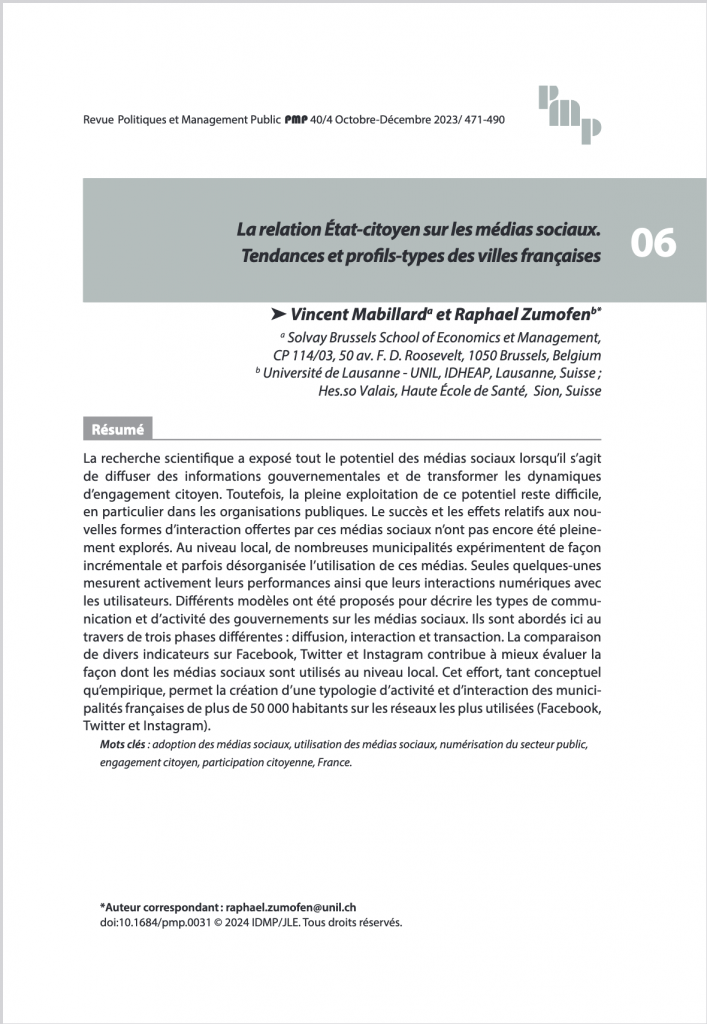
Authors : Mabillard, V., Zumofen, R.,
Publisher : Revue Politiques et Management Public (PMP) (2023)
Title :La relation État-citoyen sur les médias sociaux : Tendances et profils-types des villes françaises.
Abstract : Scientific research has exposed the potential of social media to disseminate government information and transform the dynamics of citizen engagement. However, the full exploitation of this potential remains difficult, especially in public organizations. The success and effects of these new forms of interaction offered by these social media have not yet been fully explored. At the local level, many municipalities are experimenting with these media in an incremental and sometimes disorganized way. Indeed, only a few are actively measuring their performance and their digital interactions with users. Different models have been proposed to describe the types of government communication and activity on social media. They are discussed in this article through three different phases: diffusion, interaction, and transaction. Comparing various indicators on Facebook, Twitter, and Instagram helps to better assess how social media are used at the local level. This effort, both conceptual and empirical, allows the creation of a typology of activity and interaction of French municipalities with more than 50,000 inhabitants on Facebook, Twitter, and Instagram.
Get it here !
Authors : Zumofen, R., Mabillard, V.
Publisher : Public Money & Management (2023)
Title : Debate article: Improving communication effectiveness or wasting taxpayers’ money? The use of social media influencers in public organizations.
Abstract : Recently, many organizations have identified social media influencers (SMIs) as relevant communication intermediaries, mostly because they provide access to and influence hard-to-reach stakeholders, for example teenage and young adult consumers. Research on SMIs has defined them as ‘third-party actors that have established a significant number of relevant relationships with a specific quality to and influence on organizational stakeholders through content production, content distribution, interaction, and personal appearance on the social web. With their audience considering them credible sources of information, SMIs can provide valuable support to organizations, while equally being a potential menace.
Get it here !
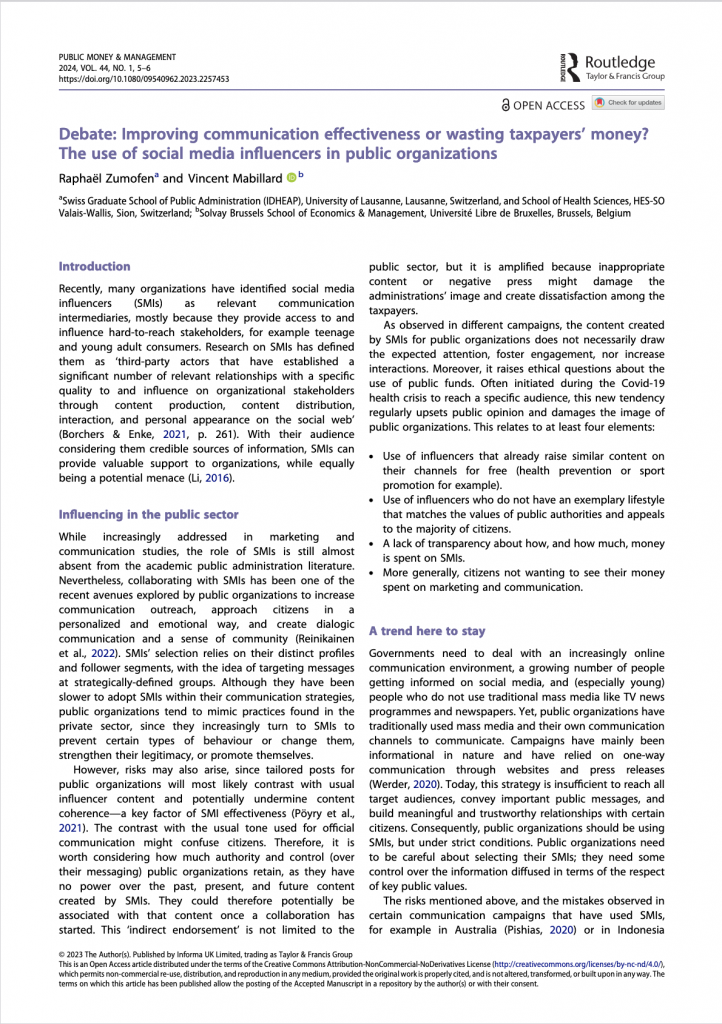
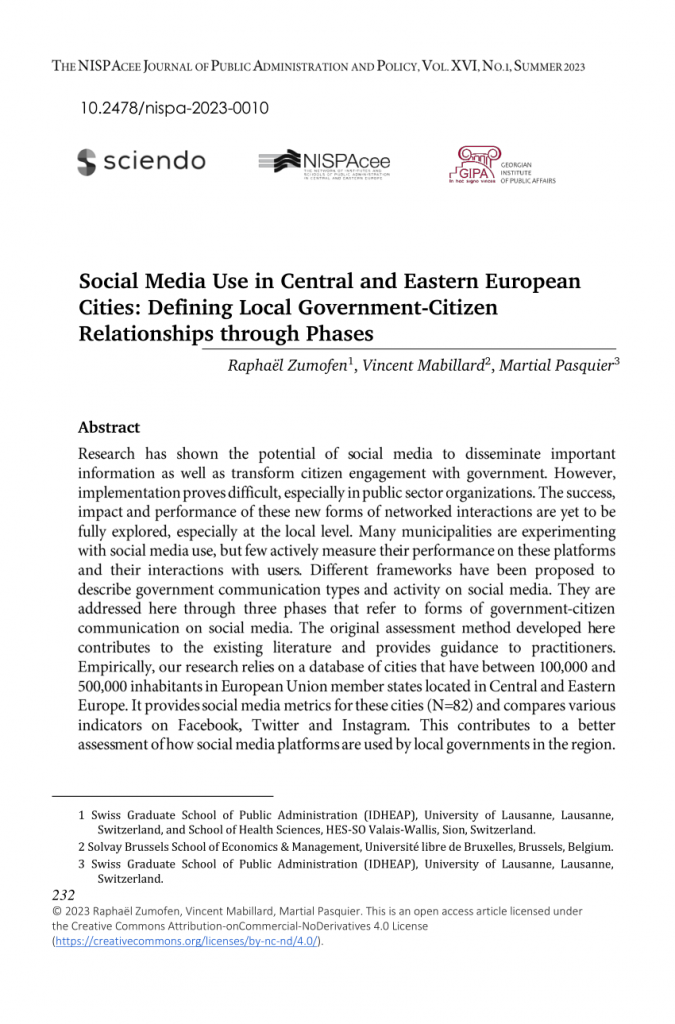
Authors : Zumofen, R., Mabillard, V., Pasquier, M.
Publisher : NISPAcee Journal of Public Administration and Policy, 16 (1), 232-253 (2023)
Title :Social media use in Central and Eastern European cities: Defining government-citizen relationships through phases.
Abstract : Research has shown the potential of social media to disseminate important information as well as transforming citizen engagement with government. However, implementation remains difficult, especially in public sector organizations. The success, impact, and performance of these new forms of networked interactions are yet to be fully explored, especially at the local level. Many municipalities are still experimenting with the use of social media, and few actively measure their performance on these platforms, as well as their digital interactions with the users. Different models or frameworks have been proposed to describe the types of government communication and activity on social media. They are addressed in this conference paper through three different phases, which refer to forms of government-citizen communication on social media. The original assessment method developed here contributes to the existing literature and provides guidance to practitioners. Empirically, our research relies on a database of cities that have between 100,000 and 500,000 inhabitants in European Union member states located in Central and Eastern Europe. It provides social media metrics for all cities included in our sample (N=82) and compares various indicators on Facebook, Twitter and Instagram, thereby contributing to better assess how social media platforms are used by local governments in the region.
Get it here !
Authors : Mabillard, V., Zumofen, R., Pasquier, M.
Publisher : International Review of Administrative Sciences (2022)
Title : Local governments’ communication on social media platforms: Refining and explaining patterns of adoption in Belgium.
Abstract : This article relies on the literature on technology adoption and empirical studies on social media adoption in the public sector to analyze the case of Belgian municipalities. Our objective is threefold as we aim to: (a) provide a new approach to assess the adoption of social media platforms by governments, (b) describe the current situation in Belgium through the concept of “active adoption” and (c) determine the main factors that relate to the uptake of Facebook in Belgian municipalities over 10,000 inhabitants. To achieve these objectives, we used software to retrieve quantitative data regarding Facebook adoption and institutionalization. Our results reveal that municipality size, median age and longevity on the platform are positively associated with the adoption of Facebook. In contrast, median income is, surprisingly, negatively associated with several dimensions of active adoption. These findings contribute to the literature on the factors related to social media use. In addition, the new ways of uncovering social media adoption and institutionalization patterns provide a solid conceptual approach for future research. For practitioners, our study provides municipalities with a better assessment framework and offers them a new model to evaluate social media adoption, underlining the fundamental difference between registration and “active adoption”.
Get it here !
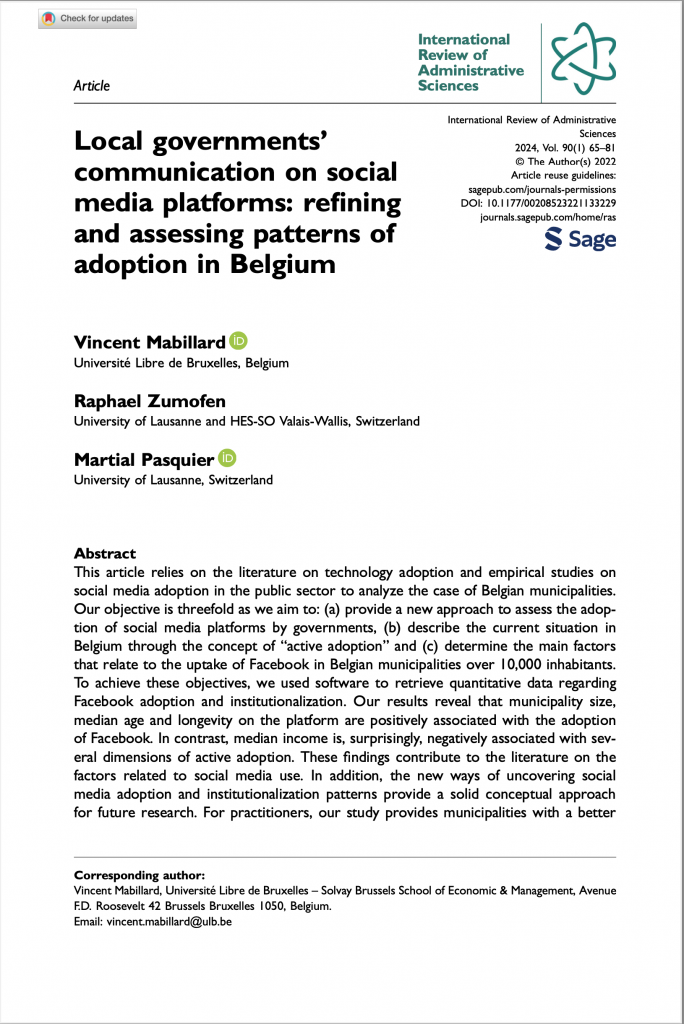

Authors : Bhatia, I., Mabillard, V.
Publisher : Electronic Government, Vol. 18, No. 2 (2022)
Title : How do cities use their communication channels? A study of social media adoption in two European federal states
Abstract : Although they often remain active on other traditional and digital channels, such as newsletters, public sector organisations are increasingly active on social media to communicate with the public. While the usage of these social media platforms has gained attention from many scholars and practitioners, the articulation of diverse channels in cities’ communication has remained under-commented. In this article, we investigate this issue through an analysis of the channels preferred by Swiss and Austrian cities to communicate with the population. The following questions are of particular interest: What are the main communication channels used by cities? And are cities that communicate through multiple channels more likely to adopt social media? Results show that cities are less active on social media than on traditional and other digital channels; however, cities present on a social media platform are more likely to extend their presence on these new channels.
Get it here !
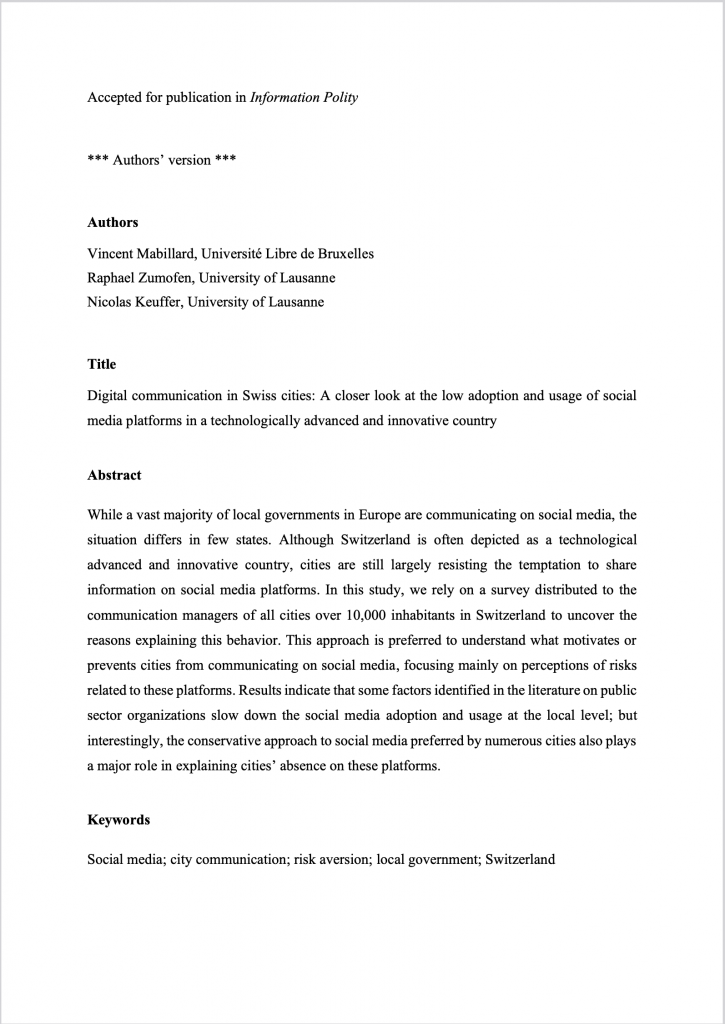
Authors : Mabillard, V., Zumofen, R., Keuffer, N.
Publisher : Information Polity, 26(4)(2021)
Title : Innovative but conservative: The paradoxical case of Switzerland regarding social media usage in local governments’ communication.
Abstract : While a vast majority of local governments in Europe are communicating on social media, the situation differs in few states. Although Switzerland is often depicted as a technological advanced and innovative country, cities are still largely resisting the temptation to share information on social media platforms. In this study, we rely on a survey distributed to the communication managers of all cities over 10,000 inhabitants in Switzerland to uncover the reasons explaining this behavior. This approach is preferred to understand what motivates or prevents cities from communicating on social media, focusing mainly on perceptions of risks related to these platforms. Results indicate that some factors identified in the literature on public sector organizations slow down the social media adoption and usage at the local level; but interestingly, the conservative approach to social media preferred by numerous cities also plays a major role in explaining cities’ absence on these platforms.
Read it here !
Other Publications
Authors : Mabillard, V., Zumofen, R.
Publisher : IGPDE (2024)
Title : Performance de la communication publique sur les réseaux sociaux : mesurer l’engagement et comprendre le rôle des influenceurs.
Abstract : Numerous academic contributions have shown that social networks make it possible to disseminate government information and transform the dynamics of citizen engagement. However, the potential for interactivity offered by these platforms remains largely untapped, particularly within public organisations. Here we describe three phases for measuring citizen engagement, and give an overview of the situation in French towns with more than 50,000 inhabitants (as at 31 July 2022). The second part of the article looks at the issues involved in mobilising influencers, an emerging practice in the public sector.
Get it here !
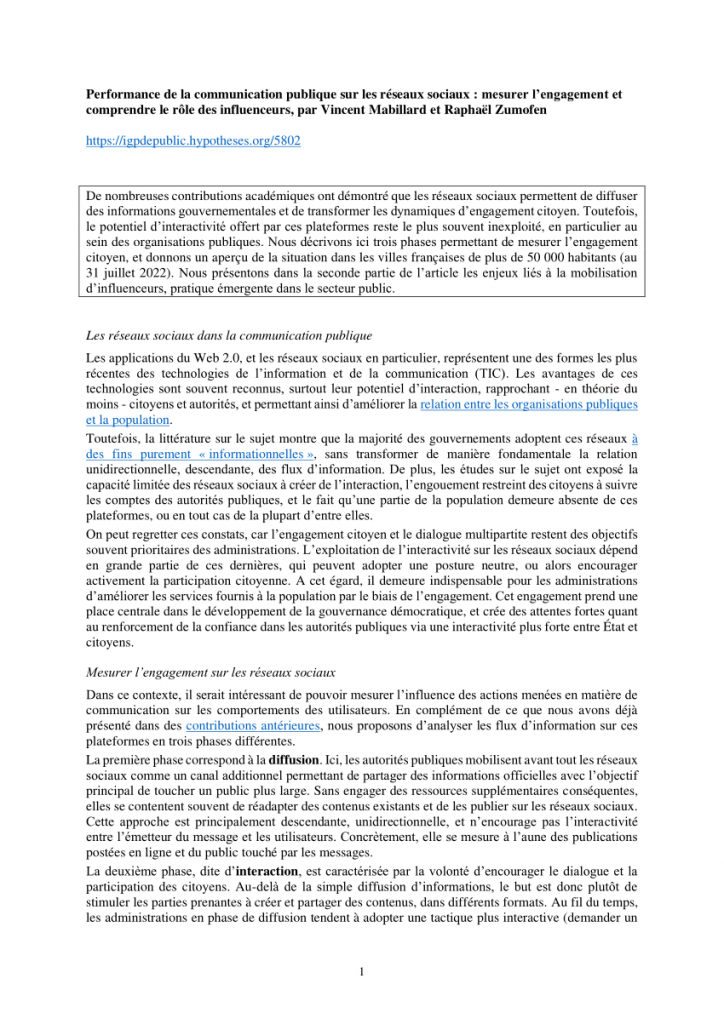
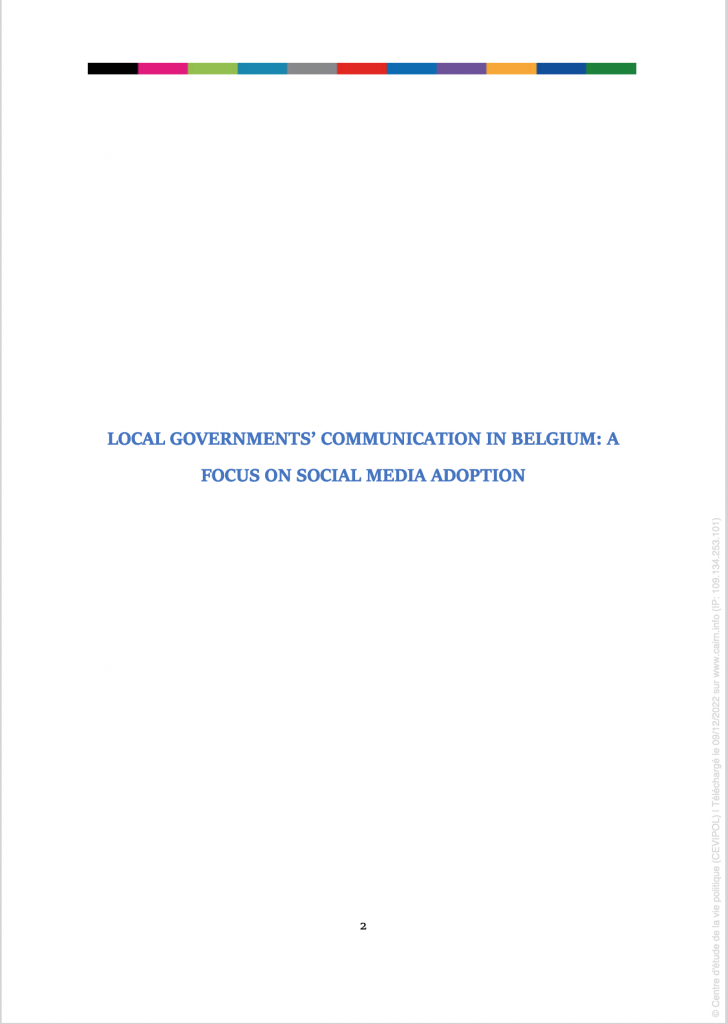
Authors : Mabillard, V., Zumofen, R.
Publisher : Working Paper du CEVIPOL. Université Libre de Bruxelles (2022)
Title : Local governments’ communication in Belgium: A focus on social media adoption.
Abstract : This article relies on the literature on public sector communication to analyse the activity of local governments on social media. We aim to describe the adoption patterns of Facebook, Twitter and Instagram in Belgian municipalities over 10,000 inhabitants. To achieve this objective, we gathered information manually and through a data retrieving software specialised on social media adoption and usage. Our findings point to a large heterogeneity of practices depending on location, size, and existing presence on social media accounts. While almost all Belgian municipalities are registered on Facebook, only a few are present on Twitter, and Instagram generally attracts more populous municipalities. In addition, patterns of social media adoption differ from province to province. We also note that while most municipalities post content quite regularly on Facebook, many are less active or publish very few posts on Twitter and Instagram.
Get it here !
Authors : Zumofen, R., Mabillard, V., Pasquier, M.
Publisher : 2022 EURAM Conference
Title : From registration to ‘active adoption’: Presenting and testing a new measurement model to assess local governments’ adoption of social media.
Abstract : Social media are extending the information and communication technology landscape in the public sector. These platforms are used increasingly as a common organizational resource by public bodies. Measuring the activity of cities on social media is thus a recurrent topic of interest among scholars and practitioners. So far, few measurement models have assessed the adoption and use of social media by public bodies in a comprehensive way. Moreover, such methods often present a discrepancy between registration on social media and what will be labelled as “active adoption” in this conference paper. Our approach builds on the literature on technology adoption in the public sphere. Based on prior conceptual developments, it presents and details a new measurement model that focuses on quantitative indicators of Facebook and Twitter adoption by local governments. This effort is then complemented by an empirical investigation of the situation in Switzerland over a three-year period (2019-2021).
Get it here !
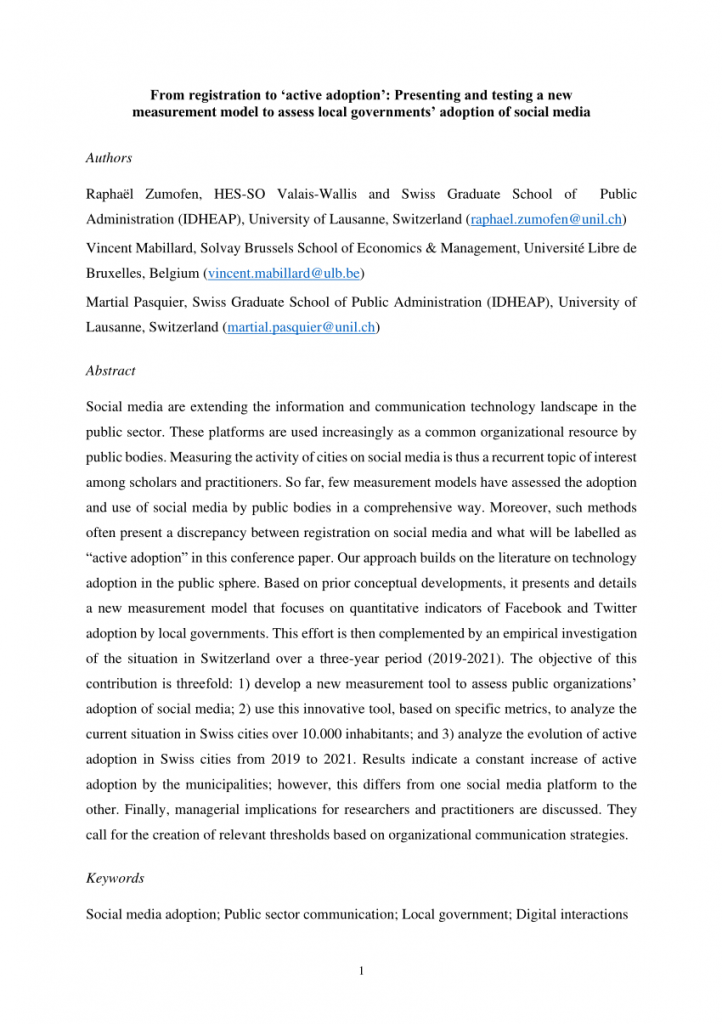
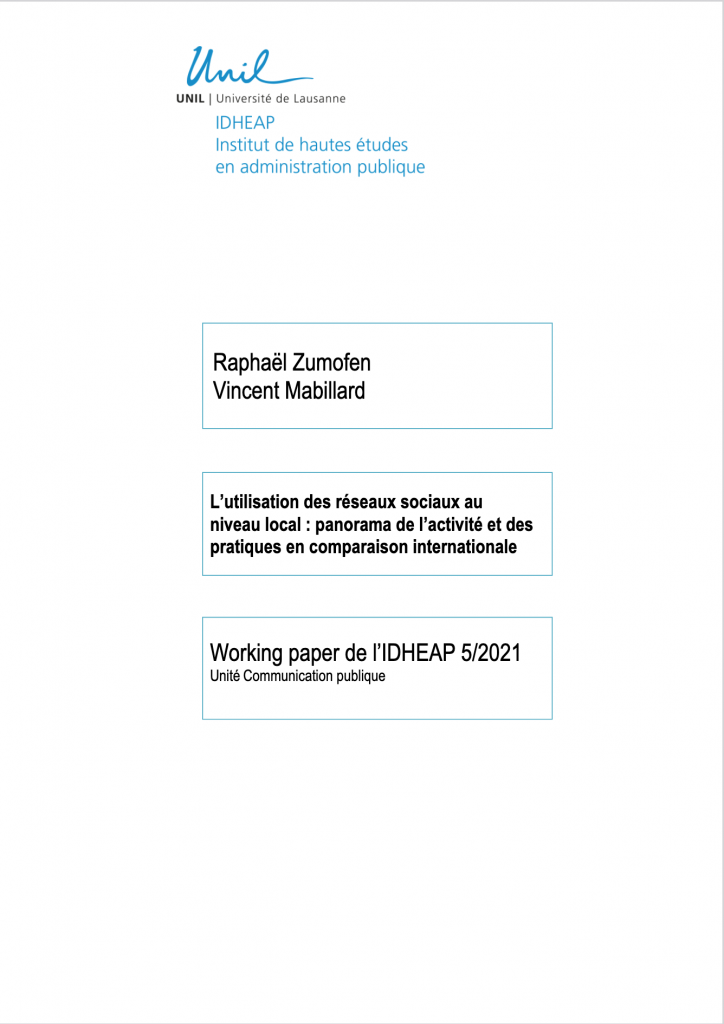
Authors : Zumofen, R., Mabillard, V.
Publisher : Working paper de l’IDHEAP, 5/2021. University of Lausanne (2021)
Title : L’utilisation des réseaux sociaux au niveau local : panorama de l’activité et des pratiques en comparaison internationale.
Abstract : As a fundamental link between those who govern and those who are governed, public communication ensures that information is disseminated to the public. It aims to enhance both the legitimacy of public organisations and social cohesion. This paper looks specifically at the digital component of public communication, with electronic media increasingly the preferred medium for relations between the state and its citizens. The growing adoption of social networks, both from the point of view of users and from that of governments and their administrations, lies at the heart of this issue. This contribution explores a subject that is still under-researched: the use of social networks by cities and the content that is disseminated on them. The first part presents an original comparative analysis of the use of social networks in five Western countries. Taking a public management perspective, and adding data gathered from municipal communication managers, the second part focuses on the Swiss case. The results highlight the importance of resources specific to the largest municipalities, the still limited interaction with the public and the absence of a real dissemination strategy. They also highlight the importance of interpersonal factors in the adoption of the networks used, as well as the types of communication mobilised on each of them.
Get it here !
Technical Reports
Authors : Mabillard, V. Zumofen, R.
Title : The use of social media in the Swiss towns and cities. Université de Lausanne (2019)
Abstract : Social network usage measured in this study focuses on the 5 platforms which, according to numerous studies, are most heavily used: Facebook, Twitter, LinkedIn, YouTube and Instagram2. Snapchat was excluded from this study since its use in the towns and cities analysed was almost nil. The results show that, in our database as a whole, 61.5% of towns are active on at least one social media platform.
Get it here !
